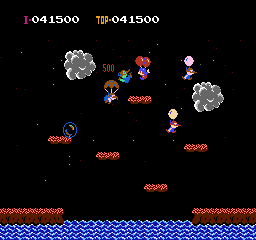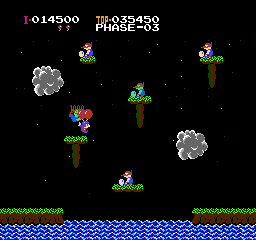Year: 1986
Publisher: Nintendo
Genre: Platform
Remember when you were a kid and balloons, powered by your imagination, could hoist you off the ground and into the stratosphere? Well, screw you, kid! That requires about a fafrillion balloons because physics, bitch! But you know where one can frequently take refuge from the doldrums of everyday physical reality? Video games, that’s where!

Balloon fight was the first Joust Clone for the NES. “Joust Clone?” you might ask, “But you haven’t gotten to Joust yet! I thought you were doing this chronologically!” Well, shut your face hole, because I’m about to school the hell out of you regarding game ports!

Sorry… where was I? That’s right – dictating to you what you should think about a video game published over two decades ago! Wait… wait, no, no I am not. I am just going to direct you to read the sub-heading on video games in the Wikipedia article on porting, thus piggybacking on the hard work of other mostly anonymous contributors. tl;dr – Joust was an arcade box, an Atari Game, a breakfast cereal and a ZX Spectrum game while Balloon Fight was still a twinkle in its daddy’s eye. Suck it, hard-working contributors! Keep telling yourself you’re contributing to the Zeitgeist with your unwarranted sense of self-importance!
In this game you’re a fellow who is somehow achieving aero-buoyancy by use of two balloons strapped to his back, although your effective weight must be slightly more than zero, since you have to wave your arms in order to achieve lift. You must do battle with a bunch of other guys who also have balloons strapped to them. You have two balloons, both of which must be popped before you plummet to the ground (I guess one’s a decoy and contributes nothing to your cumulative weight? I dunno…). Your opponents, meanwhile, have but one balloon, but all had the presence of mind to bring a low altitude parachute with them which they use to gently float to the ground and, if not prevented from doing so, use bicycle pumps to inflate other, better balloons filled with… I dunno, super air? I fail to see how a balloon inflated with a bicycle pump gives them anything approaching lift, but that’s how it seems to work.

Obviously, the best way to go about this is to just repeat to myself that it’s just a game, and my education, beyond what little programming I retained from my high school days, is really irrelevant here.
So, setting aside the absurd physics of this game world, it’s really quite enjoyable and fairly easy to summarized. Balloon Fight, unlike many joust clones, varies the patterns in which the platforms and enemies deploy, giving you some variety in that department. Having two balloons is at least somewhat merciful and Balloon fight is quite forgiving of height in collisions with enemies as joust clones go. The controls are exactly what one would suspect (that is, identical to Joust), and the sound gets a bit annoying, but is generally tolerable.
John’s Rating: 4.0 out of 5.0, getting full props for simultaneous multiplayer support, attractive graphics, enjoyable gameplay and lackluster bonus levels. Oh, wait – disregard that last one!
What if it's not the air in the balloon, but how the surface area of the balloon's material coupled with the radiation from the world's crazy black sun allows for a reaction where heavier gasses are expelled in one direction through the balloon's material (outward) while lighter gasses are drawn at an equivalent rate* in the opposite direction through the balloon's material (inward)?
* By volume, not by number of particles, obviously.
So sort of a Ranque-Hilsch vortex tube, for mass/density where, instead of acting as a Maxwellian demon, the "balloon" expels heavier/denser particles though its membrane while retaining smaller/less dense particles, accomplishing this through power acquired through radiation? If this balloon device is capable of only "breathing" at a certain rate due to particle availability, it would even explain why holding two balloons was no more effective!
Mind = BLOWN… adding Super Realism tag!
To clarify – I'm not suggesting that the AIR lacks availability of low-density particles, I'm suggesting that holding two such against one another may result in them mutually disrupting the other's processes through competitive osmosis and radiation shadowing. Still better to have two than one when the darn things are so fragile!